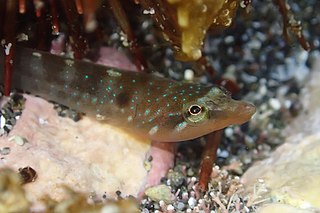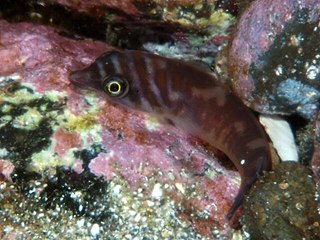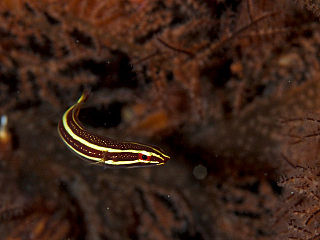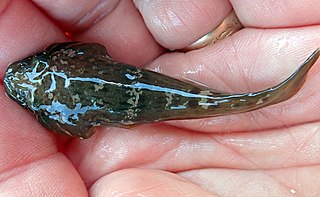
The New Zealand urchin clingfish is a clingfish. It is found around New Zealand wherever sea urchins are present. Its length is between 2 and 3 cm.

Clingfishes are fishes of the family Gobiesocidae, the only family in the order Gobiesociformes. These fairly small to very small fishes are widespread in tropical and temperate regions, mostly near the coast, but a few species in deeper seas or fresh water. Most species shelter in shallow reefs or seagrass beds, clinging to rocks, algae and seagrass leaves with their sucking disc, a structure on their chest.

Dellichthys is a small genus of clingfishes from the family Gobiesocidae which are endemic to New Zealand. It had been regarded as a monotypic genus but a second species was described in 2018.

Kuiter's deepsea clingfish is a clingfish of the family Gobiesocidae, found only off southern Australia, at depths of between 90 and 110 metres.
Derilissus is a genus of clingfishes belonging to the family Gobiesocinae found in the western Atlantic Ocean. This family of fish is identified by their appearance as small fish with sucking discs which allow them to attach themselves to various surfaces. Derilissus differs from other genera due to its attached gill membranes.

Diplecogaster is a genus of fish in the family Gobiesocidae found in Black Sea, Mediterranean Sea and Atlantic Ocean.

Gobiesox is a genus of clingfishes found in the Americas, including offshore islands. Most species inhabit coastal marine and brackish waters, but G. lanceolatus is a deep-water species found at a depth of around 300 m (980 ft), and seven species are from fast-flowing rivers and streams. These seven are the only known freshwater clingfish.

Gouania is a genus of clingfishes endemic to the Mediterranean Sea that contains at least 5 cryptobenthic species. The members of this genus are the only vertebrates to inhabit European intertidal gravel beaches and they have developed many adaptations to survive in this extremely harsh environment. They are a type of Clingfish meaning they form part of the family Gobiesocidae. All species of clingfish have a thoracic adhesive disc that allows them to hold on to both smooth and rough surfaces alike. This adaptation enables Gouania to survive the harsh conditions of gravel beaches, they are amongst the only fish taxa adapted to this habitat.
Gymnoscyphus ascitus is a small species of clingfish found in the Caribbean Sea at depths of 231 to 318 m (758–1,043 ft). This species is the only known member of the genus Gymnoscyphus.

Kopua is a genus of clingfishes found in the Pacific Ocean.

Lepadichthys is a genus of clingfishes native to the Indian and Pacific Oceans.

Trachelochismus is a genus of clingfishes endemic to the shores of New Zealand, with currently three recognized species:

Saprosites raoulensis is a species of dung beetle endemic to the Kermadec Islands in New Zealand. The holotype specimen of this species was discovered during a scientific expedition to the Kermadecs by W. L. Wallace in 1908. It was found under rotten logs on Raoul Island.
Nettorhamphos radula, the duckbilled clingfish, is a species of clingfish from the Indian Ocean off Western Australia. It is currently the sole member of the genus Nettorhamphos.

Diplecogaster bimaculata, the two-spotted clingfish, is a species of fish in the family Gobiesocidae found in Black Sea, Mediterranean Sea and Atlantic Ocean where it is found on rocks and among seagrass or shell beds.

Dellichthys trnskii, is a clingfish, the second species in the genus Dellichthys, recently discovered from intertidal and shallow coastal waters of New Zealand. Its length is between 11.9–46.0 mm.
Diplecogaster tonstricula, commonly known as the Eastern Atlantic cleaner clingfish, is a species of clingfish from the family Gobiesocidae, which is found in the tropical eastern North Atlantic Ocean. It has been observed cleaning larger species of fish.

Lepadichthys frenatus, the bridled clingfish, is a species of clingfish from the family Gobiesocidae. It is found on shallow reefs in the western Pacific Ocean.

Opeatogenys gracilis is a species of clingfish from the family Gobiesocidae which is found in the Mediterranean Sea and in the eastern Atlantic Ocean. Suggested common names for this species are the pygmy clingfish and the seagrass clingfish.
Flabellicauda is a genus of clingfishes from the Indian Ocean and Pacific Ocean.












